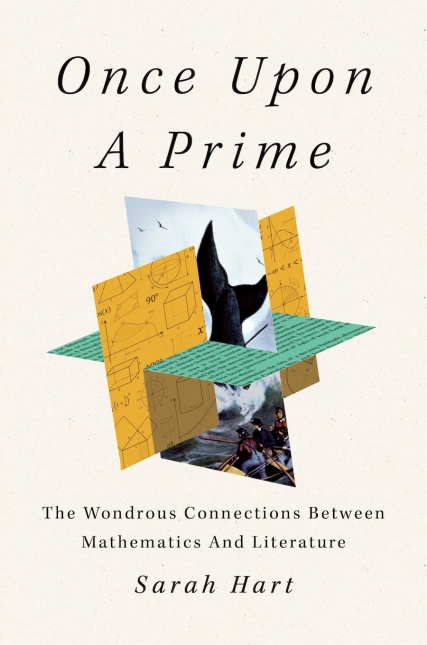Once Upon a Prime: The Wondrous Connections Between Mathematics and Literature
- By Sarah Hart
- Flatiron Books
- 304 pp.
- Reviewed by John P. Loonam
- May 3, 2023
A fascinating look at what stories and sums have in common.

In high school, I learned that the world is divided in half: Some of us are math and science people, and some of us are humanities people. I look back on that lesson with regret — it allowed me to justify my poor effort and poor grades in math class — but life has since provided a number of reasons why giving up on math was a bad idea. Now Sarah Hart has provided another one, while calling the division itself into question. Once Upon a Prime is her new study of the “Connections between Mathematics and Literature.” It is a playful, generous book that wears its considerable erudition lightly and offers a welcome mat to those of us who find ourselves on one side of the divide and trying to cross over.
Hart teaches at Gresham College, London, and is the first woman named its Professor of Geometry since the post was established in 1597. She is also an avid reader and lover of books. Here, she combines her passions to illuminate a world inside literature that most of us shy away from. She references dozens of works — providing an ample bibliography — and a wide array of mathematical concepts, discussing classics like The Canterbury Tales and Alice in Wonderland, avant-garde offerings from Raymond Queneau and Jorge Luis Borges, and titles from popular writers like Dan Brown and Michael Crichton. Her view of these authors is personal and opinionated (Brown comes in for something of a take-down) but also tightly focused on the texts themselves.
While there are charming glimmers of memoir throughout — including anecdotes about Hart’s mother and a poem written by one of her daughters — the structure of the book is carefully logical, with sections devoted to how math influences literary structures, how it can drive a narrative, and the depiction of mathematicians in literature. We dive deeper into literary (and mathematical) analysis as we move from rhyme schemes to plot devices to thematic considerations; like a Fibonacci spiral in reverse, each section starts with its simplest examples and drills down to ever more complex matter.
She begins with a look at rhyme and meter. Her explication of these topics is wonderfully clear, though she ignores how great poetry varies and often breaks these patterns in delightful ways. (Naturally, she says nothing about free verse.) The section’s real strength is in the author’s discussion of Oulipo — an avant-garde group dedicated to experiments in literary structures that functioned as a “workshop for potential literature.” Queneau, Georges Perec, and other members attempted to push literature to embrace new forms by adapting fresh constraints to work within.
Her discussion of Perec’s 1969 novel, La disparition (A Void), in which the letter “e” never appears, illustrates how mathematically difficult that achievement was. She also introduces us to the mathematic possibilities of Queneau’s 1961 Cent mille milliard de poèmes (A Hundred Thousand Billion Poems) and the geometric restrictions on the “make-your-own-adventure” genre.
While discussing these works, she asks what, for me at least, are the golden questions: “Yes, it’s clever, but why do it? Does it help to make good art?” She answers most satisfactorily in the second section, where she gives interesting analytic readings of Melville’s Moby-Dick, several George Eliot novels, Tolstoy’s War and Peace, and Vasily Grossman’s Life and Fate. In these works, mathematical concepts act not only as plot devices but as metaphors that illuminate characters and themes.
Her readings function like any theoretical lens; instead of giving a feminist or historicist analysis, however, she offers a numerist one. Every chapter is entertaining — I now understand why giants cannot roam the earth and why Jonathan Swift’s use of proportion in Gulliver’s Travels both was and was not accurate — but individual readers may find some segments more compelling than others.
The final section examines the work of writers who were themselves mathematicians (such as Lewis Carroll) or whose fascination with numbers drove some of their writing (including Edgar Allan Poe and Borges). Hart clearly explicates the central mathematical issues without ever talking down to the reader and maintains the posture she adapted right from the start — that math and literature are both fun, and that looking at them together is illuminating and enjoyable.
Of course, this is of more than mere professional interest to Hart. She finishes Once Upon a Prime with a look at how mathematicians are portrayed in literature, using as examples authors as varied as Aldous Huxley, Chimamanda Ngozi Adichie, and Stieg Larsson. She closes with an appreciation of Alice Munro’s 2009 short story “Too Much Happiness,” a fictionalized portrait of Sofya Kovalevskaya, a Russian mathematician who led a happy, well-balanced life.
Hart also makes a plea for a greater appreciation of the diversity within her profession, applauding the work of real-life mathematicians Ada Lovelace, a woman whose early work on computers was trailblazing, and David Blackwell, the first African American inducted into the National Academy of Sciences. It becomes clear that part of her mission has been to get us to look at these people more expansively. “There are as many different ways to be a mathematician as there are different ways to be a person,” she writes in a closing that’s just as much a declaration.
John P. Loonam has a Ph.D. in American literature from the City University of New York and taught English in New York City public schools for over 35 years. He has published fiction in various journals and anthologies, and his short plays have been featured by the Mottola Theater Project several times. He is married and the father of two sons; the four have lived in Brooklyn long enough to be considered natives by anyone but his neighbors.

